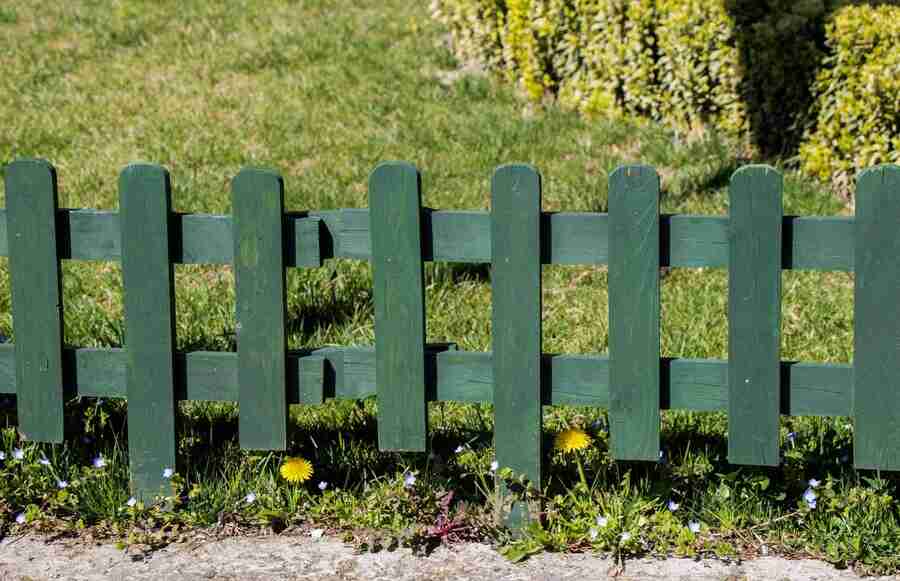
In the realm of landscape design, where every element serves as a brushstroke on nature’s canvas, the art of blending fences seamlessly into the environment stands as a testament to the harmony between functionality and aesthetics. Welcome to a world where boundaries become bridges, and barriers transform into beacons of beauty. This is the essence of the art of blending fences with landscape design.
Beyond their traditional roles as mere markers of property lines, fences possess a remarkable potential to elevate the outdoor space, enriching it with character, charm, and a sense of unity with the surrounding environment. In this blog, we embark on a journey of exploration and inspiration, delving into the intricacies of integrating fences into landscape design with finesse and creativity.
At the heart of this journey lies an understanding of the multifaceted purposes that fences serve within the landscape. They provide privacy, security, and structure, but they also have the power to define space, frame views, and enhance the overall visual appeal of the outdoor environment. By recognizing and embracing the diverse roles that fences play, we unlock their full potential as integral elements of landscape composition.
Join us as we delve into the art of selecting the right materials, colors, and styles to harmonize fences with their surroundings, creating a seamless integration that celebrates the natural beauty of the landscape. Together, we will explore practical considerations, innovative design techniques, and real-life examples that inspire and empower homeowners and designers alike to reimagine outdoor spaces as works of art. Welcome to a world where fences become more than barriers—they become catalysts for creativity, connection, and unity in landscape design.
Understanding The Purpose Of Fences In Landscape Design
In the realm of landscape design, fences serve as more than mere physical boundaries; they are pivotal elements that contribute to the overall functionality, aesthetics, and ambiance of outdoor spaces. Understanding the multifaceted purposes of fences is essential for creating harmonious and inviting landscapes.
First and foremost, fences provide privacy and security, defining the boundaries of a property and delineating private areas from public spaces. Whether it’s a secluded backyard retreat or a front yard shielded from prying eyes, fences offer a sense of sanctuary and seclusion, allowing homeowners to enjoy their outdoor spaces with peace of mind. This aspect is particularly crucial in urban environments, where privacy can be scarce.
Moreover, fences play a crucial role in enhancing safety, especially for families with children and pets. By creating a physical barrier, fences help prevent accidents and keep loved ones safe within the confines of the property. Additionally, fences can deter trespassers and intruders, acting as a first line of defense against unwanted visitors.
Beyond their practical functions, fences contribute significantly to the aesthetic appeal of landscape design. They serve as architectural elements that can complement or contrast with the surrounding environment, adding visual interest and character to outdoor spaces. Whether it’s a rustic wooden fence that blends seamlessly with a natural setting or a sleek modern design that provides a striking contrast, the choice of fence style and material can profoundly influence the overall look and feel of a landscape.
In essence, understanding the purpose of fences in landscape design involves recognizing their role in providing privacy, security, safety, and aesthetic enhancement. By carefully considering these factors, designers can create outdoor spaces that are not only functional but also visually appealing, welcoming, and harmonious.
Embracing Diversity: Types Of Fences
Fences come in a wide array of materials, styles, and designs, each offering its own unique characteristics and benefits. Understanding the diverse options available allows homeowners and landscape designers to select the perfect fence that complements the overall aesthetic and functionality of the outdoor space. Here are some popular types of fences:
- Wooden Fences:
- Traditional Charm: Wooden fences exude a timeless appeal, adding warmth and rustic charm to any landscape.
- Versatility: Available in various styles such as picket, privacy, and split rail, wooden fences offer versatility to suit different design preferences.
- Natural Aesthetics: The organic beauty of wood blends seamlessly with natural surroundings, creating a harmonious and inviting atmosphere.
- Vinyl Fences:
- Low Maintenance: Vinyl fences require minimal upkeep, making them an attractive option for homeowners seeking a hassle-free solution.
- Durability: Resistant to rot, decay, and pests, vinyl fences offer long-lasting performance, even in harsh weather conditions.
- Wide Range of Styles: From sleek modern designs to classic picket fences, vinyl offers a diverse range of styles to suit various architectural themes.
- Metal Fences:
- Elegant Sophistication: Metal fences, such as wrought iron or aluminum, add a touch of elegance and sophistication to any landscape.
- Security and Strength: Known for their durability and security, metal fences provide a sturdy barrier without sacrificing aesthetics.
- Customizable Designs: Metal fences can be customized with intricate patterns, scrolls, and finials, allowing for personalized and unique designs.
- Chain Link Fences:
- Affordability: Chain link fences are a cost-effective option for enclosing large areas while providing security and containment.
- Transparency: Their open design allows for visibility, making them suitable for properties where maintaining a clear view is desired.
- Versatile Applications: Ideal for both residential and commercial properties, chain link fences are commonly used for perimeter fencing, pet enclosures, and sports facilities.
- Composite Fences:
- Eco-Friendly: Made from a blend of recycled wood fibers and plastic, composite fences offer an environmentally sustainable alternative to traditional wood fences.
- Low Maintenance: Resistant to rot, fading, and staining, composite fences require minimal maintenance, saving homeowners time and effort.
- Modern Aesthetics: With a sleek and contemporary appearance, composite fences lend a modern flair to outdoor spaces while retaining the warmth of natural wood.
By considering the unique characteristics and benefits of each type of fence, homeowners and landscape designers can make informed decisions that enhance the beauty, functionality, and overall appeal of their outdoor environments.
Creating Visual Interest: Using Fences As Design Elements
Fences aren’t just practical boundaries; they’re also versatile design elements that can add character and charm to your landscape. Here, we’ll explore how you can leverage fences to create visual interest and enhance the overall aesthetic appeal of your outdoor space.
1. Focal Points and Statement Pieces
- Consider using a unique fence design or feature as a focal point in your landscape. Whether it’s a decorative gate, a custom-designed section, or an artistic arrangement of materials, a standout fence element can draw the eye and serve as a conversation starter.
- Experiment with different shapes, patterns, and materials to create a fence that reflects your personal style and complements the surrounding environment.
2. Adding Texture and Depth
- Enhance the visual appeal of your fence by incorporating elements that add texture and depth. For example, mixing materials like wood and metal or alternating fence panel designs can create visual interest and dimension.
- Incorporate plants, vines, or climbing flowers to soften the look of the fence and add a touch of natural beauty. Trellises, arbors, or lattice panels can provide support for climbing plants and create a lush, green backdrop.
3. Playing with Light and Shadow
- Explore the interplay of light and shadow to create dynamic visual effects with your fence. Strategically placed lighting fixtures can highlight interesting features of the fence and create a warm, inviting ambiance after dark.
- Experiment with different fence heights and slat spacing to control the amount of light that filters through, casting intriguing patterns and shadows throughout the day.
4. Incorporating Artistic Elements
- Transform your fence into a canvas for artistic expression by adding decorative elements or incorporating personalized touches. Consider installing decorative panels, metalwork sculptures, or mosaic accents that reflect your interests and personality.
- Collaborate with local artists or craftsmen to create custom-designed features that make a bold statement and infuse your outdoor space with creativity and individuality.
5. Harmonizing with Surrounding Elements
- Ensure that your fence design harmonizes with the overall aesthetic of your landscape and complements other elements such as architecture, hardscaping, and plantings. Choose colors, materials, and styles that coordinate with existing features to create a cohesive and unified look.
- Pay attention to scale and proportion to ensure that the fence enhances rather than overwhelms the surrounding environment. A well-balanced design will create visual harmony and enhance the overall appeal of your outdoor space.
By embracing fences as design elements, you can elevate the visual appeal of your landscape and create a cohesive and inviting outdoor environment that reflects your unique sense of style and personality. Experiment with different ideas and techniques to discover the perfect combination that transforms your fence from a functional necessity into a striking design feature.

Trends And Innovations In Fence Design
- Sustainable Materials: With a growing emphasis on eco-conscious living, there’s a rising demand for fences made from sustainable materials. Bamboo, reclaimed wood, and composite materials made from recycled plastics are gaining popularity for their durability and environmentally friendly qualities.
- Living Fences: Also known as green fences or living walls, these are composed of living plants trained to grow along a structure. Living fences not only provide privacy and security but also contribute to biodiversity, air purification, and aesthetic appeal. They offer a dynamic, ever-changing aspect to outdoor spaces.
- Modular Fence Systems: Modular fence systems offer flexibility and customization, allowing homeowners to create unique designs tailored to their preferences. These systems often feature interchangeable panels, posts, and accessories, giving users the freedom to modify their fence layout and style easily.
- Tech-Integrated Fences: Technology is finding its way into fence design with the integration of smart features such as LED lighting, motion sensors, and even security cameras. These tech-enhanced fences provide added functionality, convenience, and security, allowing homeowners to monitor their property more effectively.
- Minimalist Designs: In line with the minimalist aesthetic trend, fence designs are becoming sleeker and more streamlined. Clean lines, simple profiles, and monochromatic color schemes contribute to a contemporary look that complements modern architectural styles.
- Vertical Gardens: Similar to living fences but with a focus on vertical gardening, these fences incorporate pockets or trellises for planting flowers, herbs, or vegetables. Vertical gardens not only soften the appearance of fences but also maximize outdoor space for urban gardening and contribute to urban biodiversity.
- Artistic Elements: Fences are increasingly seen as opportunities for artistic expression. From intricate metalwork to colorful murals, homeowners are incorporating artistic elements into their fence designs to make a bold statement and showcase their personality.
- Mixed Materials: Mixing different materials such as wood, metal, glass, and stone adds visual interest and texture to fence designs. Combining materials allows for creative expression while also addressing practical considerations such as durability and maintenance.
- Climate-Adaptive Design: With climate change influencing weather patterns, there’s a growing need for fences designed to withstand extreme conditions such as high winds, heavy rain, and fluctuating temperatures. Climate-adaptive fence materials and construction methods help ensure longevity and resilience in challenging environments.
- Interactive Features: Some innovative fence designs incorporate interactive elements such as built-in seating, planters, or water features. These features not only enhance the functionality of the fence but also encourage interaction and engagement within the outdoor space.
In conclusion, the art of blending fences with landscape design is a testament to the transformative power of thoughtful integration. Beyond mere boundary markers, fences serve as canvases for creative expression and vital components of outdoor spaces. By embracing trends and innovations such as sustainable materials, living fences, and minimalist designs, homeowners and designers alike can elevate their landscapes to new heights of beauty, functionality, and sustainability. Whether seeking privacy, security, or simply a stunning outdoor retreat, the careful selection and seamless integration of fences can truly redefine the ambiance and character of any outdoor space. So let’s embrace this art, forge connections between structure and scenery, and embark on a journey of exploration and imagination in crafting outdoor spaces that inspire and delight for years to come.
 Se Habla Español
Se Habla Español


